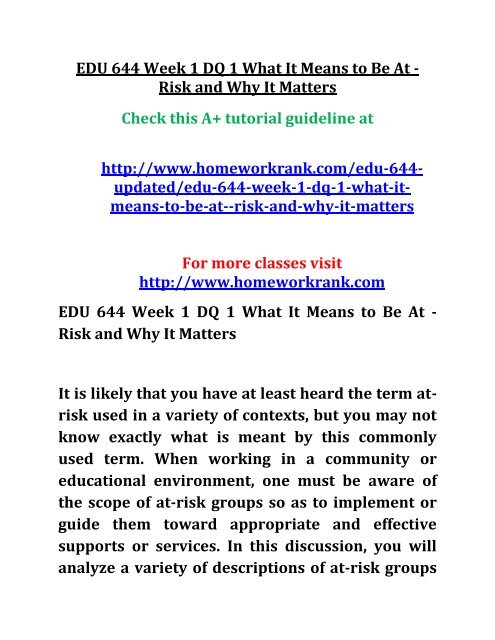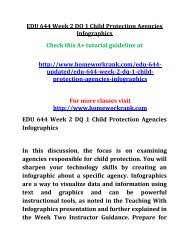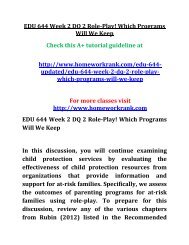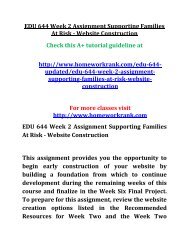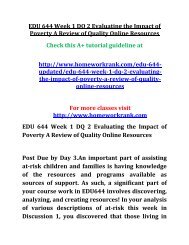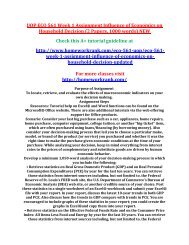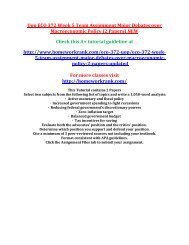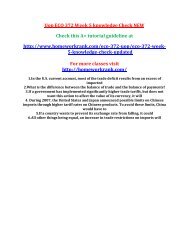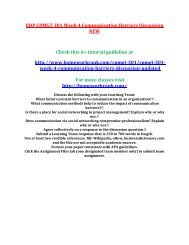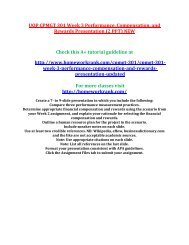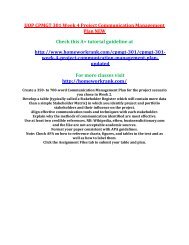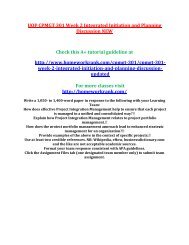EDU 644 Week 1 DQ 1 What It Means to Be At - Risk and Why It Matters
Create successful ePaper yourself
Turn your PDF publications into a flip-book with our unique Google optimized e-Paper software.
<strong>EDU</strong> <strong>644</strong> <strong>Week</strong> 1 <strong>DQ</strong> 1 <strong>What</strong> <strong>It</strong> <strong>Means</strong> <strong>to</strong> <strong>Be</strong> <strong>At</strong> -<br />
<strong>Risk</strong> <strong>and</strong> <strong>Why</strong> <strong>It</strong> <strong>Matters</strong><br />
Check this A+ tu<strong>to</strong>rial guideline at<br />
http://www.homeworkrank.com/edu-<strong>644</strong>-<br />
updated/edu-<strong>644</strong>-week-1-dq-1-what-itmeans-<strong>to</strong>-be-at--risk-<strong>and</strong>-why-it-matters<br />
For more classes visit<br />
http://www.homeworkrank.com<br />
<strong>EDU</strong> <strong>644</strong> <strong>Week</strong> 1 <strong>DQ</strong> 1 <strong>What</strong> <strong>It</strong> <strong>Means</strong> <strong>to</strong> <strong>Be</strong> <strong>At</strong> -<br />
<strong>Risk</strong> <strong>and</strong> <strong>Why</strong> <strong>It</strong> <strong>Matters</strong><br />
<strong>It</strong> is likely that you have at least heard the term atrisk<br />
used in a variety of contexts, but you may not<br />
know exactly what is meant by this commonly<br />
used term. When working in a community or<br />
educational environment, one must be aware of<br />
the scope of at-risk groups so as <strong>to</strong> implement or<br />
guide them <strong>to</strong>ward appropriate <strong>and</strong> effective<br />
supports or services. In this discussion, you will<br />
analyze a variety of descriptions of at-risk groups
<strong>and</strong> behaviors associated with them for the<br />
purpose of acquiring your own working definition.<br />
You will include this definition in your website<br />
that is created throughout the course <strong>and</strong> finalized<br />
during the <strong>Week</strong> Six Final Project <strong>and</strong> make<br />
adjustments <strong>to</strong> your working definition during<br />
<strong>Week</strong> Six when you reflect upon how your<br />
definition has exp<strong>and</strong>ed.<br />
Prepare for this discussion by reading the <strong>Week</strong><br />
One Instruc<strong>to</strong>r Guidance <strong>and</strong> reviewing the<br />
following resources that provide descriptions of<br />
at-risk groups <strong>and</strong> the behaviors associated with<br />
them:<br />
U.S. Department of Health & Human Services: <strong>At</strong>-<br />
<strong>Risk</strong> Individuals<br />
• A website defining at-risk individuals.<br />
U.S Department of Health & Human Services:<br />
Fac<strong>to</strong>rs That Contribute <strong>to</strong> Child Abuse <strong>and</strong> Neglect<br />
• A website about child abuse <strong>and</strong> neglect.
American Academy of Child <strong>and</strong> Adolescent<br />
Psychiatry<br />
• An article describing violent behavior in<br />
children <strong>and</strong> adolescents.<br />
Teachnology<br />
• A website defining the concept of being at-risk.<br />
National Center for School Engagement<br />
• A website offering descriptions for youth at<br />
risk.<br />
Initial Post: Considering the descriptions in the<br />
websites provided above, create an initial post<br />
that addresses the following:<br />
a. Discuss which of the websites most effectively<br />
described the term at-risk as it relates <strong>to</strong><br />
establishing <strong>and</strong> enhancing your underst<strong>and</strong>ing of<br />
the phrase.<br />
b. Write a working definition of the term at-risk<br />
in your own words. Review the <strong>Week</strong> One
Instruc<strong>to</strong>r Guidance for what constitutes a<br />
working definition.<br />
c. Explain what the personal value is in having<br />
knowledge of groups at risk in relation <strong>to</strong> your<br />
current or anticipated future work with children<br />
<strong>and</strong>/or families.<br />
Guided Response: Respond <strong>to</strong> at least two peers. In<br />
your responses, discuss how your peers’ selections<br />
of effective website descriptions compare <strong>to</strong> your<br />
own <strong>and</strong> offer feedback on their definition of “atrisk”<br />
giving specific suggestions that will enhance<br />
their definition. Additionally, consider your peers’<br />
explanations of the value of having awareness of<br />
groups at risk <strong>and</strong> discuss how their ideas for this<br />
value differ from your own. Asking questions of<br />
peers that clarify points from their initial posts is<br />
also encouraged. Though two replies is the basic<br />
expectation for this discussion, for deeper<br />
engagement <strong>and</strong> learning you are encouraged <strong>to</strong><br />
provide responses <strong>to</strong> any comments or questions
others have given <strong>to</strong> you. Remember that for all<br />
discussions in this course, continuing <strong>to</strong> engage<br />
with peers <strong>and</strong> the instruc<strong>to</strong>r beyond the<br />
minimum requirements will further the<br />
conversation <strong>and</strong> provide opportunities for you <strong>to</strong><br />
demonstrate your content expertise, critical<br />
thinking, <strong>and</strong> real-world experiences with the<br />
discussion <strong>to</strong>pics.


